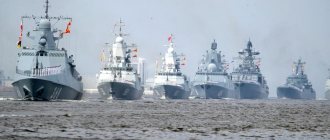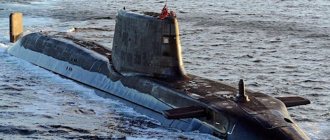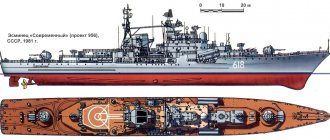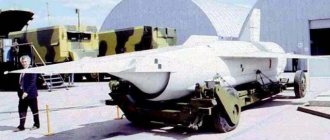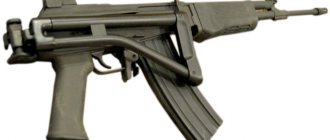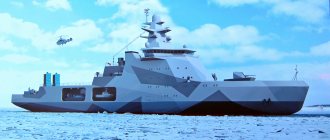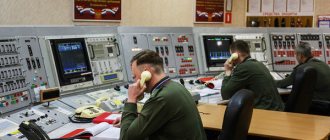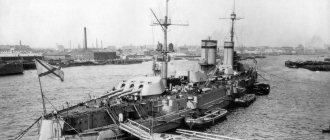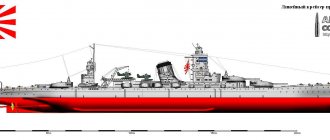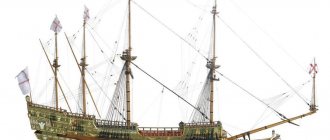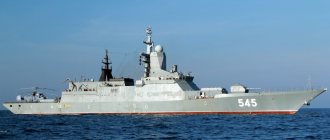One of the previous materials told our readers the story of the legendary combat ekranoplanes of the Soviet Union and their creator, Rostislav Alekseev, who became a legendary aircraft designer.
But nothing comes from nothing: Alekseev became famous thanks to more successful projects that conquered the whole world long before the fame of the “Caspian Monster”.
Some of his creations still roam our country.
Have you already guessed? That’s right, today we will talk about the “winged ships” developed in his design bureau. And not only.
Theory. How hydrofoils work
The principle of operation of hydrofoils Hydrofoils
have become a continuation of the so-called planing ships or gliders: small boats, speedboats and even surfboards.
Planing is movement through water due to speed, sliding along the surface, during which the fluid resistance sharply decreases.
Hydrofoils were a logical development of the idea: they force the ship to rise when it reaches a certain speed, reducing water resistance and improving motion dynamics.
The plane literally “takes off” in the water column, using its lifting force.
Diagram of a hydrofoil ship
When stationary and traveling at low speed, a hydrofoil vessel is kept afloat by the Archimedes force, just like an ordinary displacement vessel.
The contact area with water and water resistance are reduced, which allows you to develop a higher speed.
Cruising speed reaches 100 km/h, and for a number of military vessels - even 180 km/h. About 2-5 times faster than conventional ships.
At high speeds, the wing “boils” due to a sharp decrease in pressure in front of it. The effect of “cavitation” occurs, which is used by ships with an air cavity.
High-speed fleet: how was it?
In 1941, in Nizhny Novgorod (which at that time was called Gorky), a thesis devoted to a glider with wings under water was defended at the Industrial Institute. The author of this project was Rostislav Alekseev - the same one who in the future would give Khrushchev a ride around Moscow.
The drawings demonstrated to the commission an excellent vessel with high speed performance. It had to work according to a principle that had never been implemented by anyone before. There was simply nothing like it in the world at that time. To say that the jury was stunned would not half express their delight and surprise.
And another theory. What types of hydrofoils are there?
Partially submerged wing
There are two types of hydrofoils:
- partially submerged - U-shaped
- fully submerged - in the shape of an inverted T
Partially submerged wings, when moving at full speed, are at the boundary between water and air, lifting the body above the water.
Modern fully submerged wing
Submerged wings are a recent development: although they reduce pitching to zero, they require constant correction and control, which has only been possible thanks to modern computers.
They are used by hybrid vessels that combine a conventional hull that does not use planing and hydrofoils to reduce pitching while moving.
The history of this design goes back many years, many important milestones and discoveries. Almost every one is associated with the Russian aircraft designer Rostislav Alekseev and his design bureau.
But was Rocket the first?
Nowadays, few people remember this, but “Rocket” was not the first attempt to create a transport of this type. Even before it, developments were underway that suggested that the best speed performance could be achieved if wings were placed under the ship’s hull. The idea of such a vessel was first born in the 19th century!
Why was it not possible to construct anything sensible before Alekseev did? At first, steam engines were used, the power of which is quite limited. There simply weren't enough of them to reach the speed at which the wings would be truly useful. Therefore, at that stage everything ended with fantasies and assumptions of “how this could be.” However, these were interesting times: the public regularly saw new types of hulls and specific structures, ships set records, but months passed and new ships broke them. This race seemed endless. The first ship equipped with wings under water was popularly nicknamed the “frog.” Although it moved quickly, it bounced on the surface of the water and was quite unstable.
The very first hydrofoil ships
One of the first hydrofoils
The first hydrofoils were described in 1869 by the Frenchman Emmanuel Denis Farcot in a patent:
“Fixing inclined planes or wedge-shaped elements on the sides and bottom of the vessel, which, when the vessel moves forward, will lift it in the water and thus reduce drag.”
However, despite much work, the real prototype of the vessel was tested in France only in 1887.
The first Russian patent was filed by Comte de Lambert in 1891: his vessel was supposed to rise above the water with wings with independent adjustment on the sides of the vessel.
Hydrofoil prototype by Enrico Forlanini
Qualitative results appeared only in 1906, when the Italian Enrico Forlanini used an experimental model of a boat with a speed of 68 km/h.
In the same year, the first theoretical publication by the American William Meacham on the movement of ships with similar aerodynamic elements.
The British designer Thorneycroft also developed a series of unique models at the turn of the century, but was able to implement them only by the end of the First World War.
A prototype of Alexander Graham Bell's hydrofoil being tested
Later, Alexander Bell created a prototype of the vessel, which reached a speed of 111 km/h.
In the USSR, the topic was studied by TsAGI engineers: they built the first prototype and developed the fundamental theory of hydrofoil propulsion.
In addition, the studied effects of “cavitation” and “supercavitation” became the impetus for the emergence of not only “winged” ships, but also many other hybrid methods of movement of a wide variety of bodies - from ships to artillery shells.
The propeller is in operation. Cavitation air bubbles are clearly visible
Cavitation is a physical phenomenon in which tiny bubbles filled with steam appear in a liquid behind a fast-moving object. Initially it was considered a negative effect that reduced the performance of ships.
Supercavitation is the effect of “smoothing” cavitation with the help of its preliminary amplification, developed by academician V.L. Pozdyunin.
However, none of the projects became a prototype of a production vessel - most of them did not leave the stage of preliminary modeling or the stage of a scale model to check the performance properties in test baths.
How was this conceived?
Looking at how successful the ship has become, it seems that this is what the government planned. But was it really like that? The project was developed under the control of the Ministry of Shipbuilding and was financed by the state - this fact is indisputable. But historical reports prove that officials did not connect real expectations and hopes with these models. This was largely due to the non-standard nature of the idea as such - they were afraid that it might completely burn out. And there was a time when it was very easy to remain “misunderstood,” which could not only become a nuisance, but lead to complete collapse.
In an effort to do everything possible, the brilliant Soviet shipbuilder Rostislav Alekseev set himself the maximum task - to design and build a ship and demonstrate it not just to anyone, but immediately to Khrushchev himself, that is, bypassing all lower-level authorities. This daring plan had a chance of success and was implemented in the summer of 1957. The ship "on all wings" rushed along the Moscow River and was moored not at a random pier, but where the General Secretary usually liked to stop. Alekseev personally invited Nikita Khrushchev on board. And so began the swim that allowed the ship to become legendary. Even then, the main person of the country appreciated the admiration of the public for the ship that overtook everyone. And the Secretary General himself was impressed by the speed. It was then that the phrase was born, preserved for posterity: “We’ll stop riding oxen along the rivers! Let's build!"
Alekseev's first winged ships. Inventions and prototypes
Unfortunately, without the Internet and modern scientific approaches that require actively publishing achievements and corresponding with colleagues, Rostislav Alekseev had to create a lot from scratch.
The task of creating a high-speed ship captured Alekseev so much that it was this project that formed the basis of his thesis at the Gorky Industrial Institute (today - Nizhny Novgorod State Technical University named after Alekseev), defended on October 1, 1941.
Alekseev's graduation project: planing torpedo boatThe talent was sent to monitor the build quality of the legendary T-34 hydrofoil model (SPK) appeared.
Theoretical calculations led Alekseev to the traditional layout of such ships for Soviet and Russian shipbuilding with 2 horizontal load-bearing planes-wings with low immersion.
Such a ship, when reaching cruising speed, comes out of the water not only with its hull - it “flies” on its wings, which end up exactly on the surface of the liquid.
And by October 10 of the same year, the project received a negative review from Kuznetsov, who was in charge of the development and production of ships in the Soviet Union.
Prototype of ekranoplan SM-1 based on A-4
However, the plant employees provided Alekseev with the opportunity to complete the project and even build the first two-seater glider A-4 (“Alekseev 4 meters long”), tested in 1943.
The success of the project made it possible to create a larger hydrofoil boat A-5 , which achieved incredible aerodynamic quality and a speed of 85 km/h, impossible for ships of that time (with the average speed of warships up to 30-40 km/h today).
Production in earnest
When the Raketa boats showed their excellent parameters, proved their reliability and it became clear that they had considerable prospects, the government decided to launch mass production of these ships. The task was entrusted to the company located in Feodosia. Somewhat later, it was possible to establish the production of ships in the following cities:
- Leningrad;
- Khabarovsk;
- Nizhny Novgorod;
- Volgograd.
Production was also set up on the territory of Georgia, in the city of Poti.
Manufactured ships were exported to:
- Finland;
- Romania;
- Lithuania;
- China;
- Germany.
And today “Rockets” are running in some of these countries. Over time, many ships were converted into summer cottages, restaurants, and cafeterias.
Combat hydrofoil boats. The first serial SPK
Project 123K torpedo boat “Komsomolets”As a result, Alekseev received the task of developing a promising combat vessel. The basis of the first hydrofoil combat ship was a dozen serial torpedo boats of Project 123K.
The wings developed by the designer were given to hulls that were already in the stocks, but which at the same time lost their armor. The main defense of the “mosquito”, as sailors often call them, was speed: the Project 123K type “Komsomolets” (A-11) developed 50 knots (90 kilometers per hour) with a draft of only 0.8 meters.
Such a one could plow the seas, fearlessly diving into adjacent rivers. A pair of torpedo tubes with 3 machine guns were sufficient for coastal patrols. Shot and ran away.
Next came the modernized Project 184 boat of slightly larger dimensions, which later received an RD-9 turbojet engine in addition to the bow wing. The same one that carried Soviet Li-Ci-Novs in the MiG-19 in Vietnam.
Thanks to this, the ship reached a record speed of 69 knots, which is 127 kilometers per hour. But one torpedo tube with a couple of warheads seemed not enough.
Therefore, the project was forgotten, and then the patrol SPK Project 125A with bomb releasers instead of torpedo tubes. A total of 16 copies were produced from 1963 to 1967.
Alekseev's developments later served as support for the work of TsKB-5 (TsMKB "Almaz"): serial missile carriers of Project 206-M "Storm" and 206ME "Vikhr" and a unique missile ship of Project 1240 "Uragan" with titanium wings.
Alekseev’s Central Design Bureau returned to the topic of warships only with project 133 “Antares”, designed for the naval units of the KGB. They managed to serve as part of the border units until 2010.
A pair of gas turbine units accelerated these torpedo boats to 112 km/h. Among serial ships, their equal never appeared.
American admirals' nightmare
A group of ships of the American fleet, led by an aircraft carrier, is on combat duty in the World Ocean. Radars do not detect any threats, and calm reigns on American ships. It is disrupted by the sudden visual detection of a target on the horizon - either a ship rushing at incredible speed, or an airplane literally gliding above the surface.
Before our eyes, the unidentified target grows into a huge “flying ship.” The alarm was announced on the aircraft carrier, but it was too late - the “alien” fired a missile salvo, and after a few tens of seconds, the pride of the fleet, engulfed in fires and torn to pieces, sank to the bottom. And the last thing the dying sailors see in their lives is the shadow of an unknown and terrible enemy rapidly disappearing beyond the horizon.
Such or similar nightmares tormented American military leaders at night who had information about the secret weapon of the USSR - the Lun attack ekranoplane of Project 903.
WIG "Lun", Kaspiysk, 2010. Photo: Commons.wikimedia.org/ Fred Schaerli
The ekranoplan, more than 73 meters long and almost 20 meters high, could move at speeds of up to 500 km per hour above the surface of the water at an altitude of about 4 meters. It was armed with Mosquito anti-ship missiles, which made it possible to inflict maximum damage on enemy ships. "Lun" received the nickname "aircraft carrier killer."
The amazing combat vehicle was developed at the design bureau of Rostislav Alekseev, a Soviet designer whose developments revolutionized shipbuilding.
The first passenger hydrofoil ships: “Rocket” and “Meteor”
In parallel with the missile boat, Alekseev in 1949 proactively developed the high-speed passenger A-7 , which became the standard cruise ship.
Even today, ships built on the basis of Alekseev’s seventh design ply the country’s rivers: the same “Meteors” and “Comets”, familiar to many from childhood, have become the serial embodiment of the design.
They retain the proportions, the general layout of the hydrofoils and even their profile. But recognition did not come immediately, because at the beginning of the SEC era no one was thinking about passengers.
Only the appearance in 1955 of serial passenger hydrofoil ships Supramar PT 20 changed the opinion of state leaders.
The secrecy was removed from the hydrofoils, and in 1957, based on the missile boats and the A-7 project, the designer, with the support of the government, launched the lead motor ship “Raketa”.
Having appeared at the Festival of Youth and Students, the amazing aircraft-ship created a sensation on a global scale, naturally receiving a serial continuation.
Afterwards, the first experimental “Rocket” was sent for trial operation on the Volga on the Gorky-Kazan line: the ship covered a distance of 420 km in 7 hours versus the usual 30.
From 1959 to 1976, 389 “Rockets” were built, of which 30 were exported to the most unexpected countries. For a long time they were not only transport, but also a popular form of recreation.
“Rockets” were operated between the cities of Tartu and Pskov, on Lake Ilmen, on the route Novgorod - Staraya Russa and back, between Cologne and Dusseldorf on the Rhine, and plowed the Thames between London and Gravesend.
They were in Canada, the USA, and even Nicaragua. You don’t even have to think about the countries neighboring the USSR.
In 1958, the first improved passenger hydrofoil ship, the Meteor, was launched, which, together with the Raketa, became the main means of river transport for many years.
It was designed for 64-66 passengers, the second, depending on the modification, could accommodate from 74 to 128 people. Twice as much as on the bus.
At a cruising speed of 60 kilometers per hour along the shortest waterway, they had no equal in the Union: there was no faster, more convenient, more reliable transport.
Giants 30 meters long became the basis of the Soviet river fleet, without losing the ability to enter most river ports. In total, about 400 ships of this type were produced.
The Meteor, upgraded for marine conditions, was named Comet. These ships, like their predecessors, were just as highly regarded by Western countries: only 52 ships out of 86 remained in the USSR.
"Meteor" became the most famous of all hydrofoils, the most common. But not the last - and not the best.
Present and future
Since the Raketa boat (vessel speed up to 70 km/h) showed such excellent parameters, it quickly gained popularity. The name of this vessel almost immediately became a household name among the people. This tradition has been preserved to this day - today all ships that resemble a classic Soviet motor ship are called “rockets”.
During the Soviet period, the river boat “Raketa” was not available to everyone. Wealthy families could afford a weekend trip to some beautiful region: pilots took their passengers to charming bays and coves inaccessible to those traveling by land. But the price for such a cruise was steep. For example, electric trains, which could take you the same distance from the city, were several times cheaper. Nevertheless, it was simply impossible to imagine a better holiday on the water for the whole family than the Raketa boat.
Nowadays, this ship is used daily. For example, it can be seen at the Nizhny Novgorod river station. Day after day, faithful ships transport passengers between cities and take tourists on excursion routes.
The second generation of Alekseev’s “winged ships”
In 1964, the Alekseev Central Design Bureau developed the gas turbine ship “Burevestnik”: with a length of 42 meters, it could reach a design speed of 150 km/h, carrying up to 150 people.
The only copy, despite its status, was operated on the route Kuibyshev - Ulyanovsk - Kazan - Gorky, and after - Yaroslavl - Gorky. A faster way to move around the country had not yet been invented.
The history of the ship ended only in 1993, when it was sold for scrap. And this is despite more complex management than most SPCs.
The only larger one was Sputnik, which was launched in 1961: its length was 47 meters and its passenger capacity was 300 people! Unfortunately, the accident forced it to be taken out of service.
Meanwhile, its marine version called “Whirlwind” was supposed to be able to “fly” in a storm of 8 points. But the body made of aircraft aluminum, as well as the incredible gluttony of the engines, put an end to it.
Developments on these types formed the basis of the Voskhod project, which replaced the obsolete “Rockets” and “Meteors” by the early 70s.
The first ship of the series was built in 1973. A total of 150 Voskhods were built, some of which were exported (China, Canada, Austria, Hungary, the Netherlands and others).
The main customer in the 2000s was the Dutch public transport operator Connexxion. The Netherlands retired the last Meteor in 2004 and the Voskhods in 2014.
Hungary, Bulgaria, China, Egypt, Czech Republic, Greece, Vietnam, Morocco and Romania still operate the remaining ships.
The story doesn't end
Yes, “Rockets” were popular, they were the pride of the nation, they were loved, known, admired, and money was paid for them. But time passed, the ships gradually became obsolete. Of course, at first they were repaired, but when the Secular Union went downhill, there was no time for ships. The technical and moral wear and tear of river transport only increased. At some point, it seemed that this area of transportation had virtually no future, at least not in the coming decades.
And a few years ago they launched a program designed to revive the best motor ships of the Soviet Union - “Rockets”. And together with them, it was decided to invest money in “Comets” and “Meteora”. Despite the rather difficult economic situation in the country, the government was able to allocate money for work to improve transport and modernize ships to meet the needs of modern times. A special program was developed to support ships with wings under water. The year 2016 became important, when the Comet 120M vessel was supposed to demonstrate that the efforts made had not gone to waste.
Hydrofoils for shallow waters: “Belarus”, “Polesie” and “Valdai”
After serial production of hydrofoil vessels for lakes, seas and large rivers was established, the Central Design Bureau for SPK (Gorky) began to develop SPK for small rivers.
First, they decided to modify the Raketa SPK in order to reduce the draft, and for some time, along with the conventional Raketas, the Raketa-M was produced.
This was not enough, so in 1962 the experimental SPK “Chaika” was created with an even smaller draft.
As a continuation of these two projects, the shallow-draft SPK "Belarus" with a draft of only 30 centimeters was designed and put into production.
A shallow draft was achieved thanks to a radical modification of the propulsion-steering complex of the serial SPK: a specially designed propeller was located above the wing system and operated in the crest area of the aft wing under conditions of incomplete immersion.
This allowed the vessel to approach the piers of villages and other small settlements, as well as to operate in the upper reaches of rivers and during “low water”.
In the 1980s, to replace the vessels of the Belarus and Raketa-M types (a version with a draft reduced to 1.2 meters - versus 1.8 meters for the conventional Raketa), a new SPK Polesie was designed. Motor ships of this type were produced at the Gomel Shipbuilding and Shiprepair Plant from 1983 to 2008.
SEC "Polesie" was exported not only to the CMEA countries, but also to Western Europe. After 1991, China bought many ships, giving them the new name “Longtan”.
Based on it, a modernized version of Polesie was developed - project 21380 Valdai 45R, the first series of which of 6 ships was launched in 2022.
It is designed for high-speed passenger transportation over a distance of up to 400 kilometers along small rivers and reservoirs. The design of the SPK allows passengers to disembark even on an unequipped shore
Five Valdaevs are operated in the Nizhny Novgorod region, two in the Ob-Irtysh basin. Contacts for further production have also been concluded, and deliveries to foreign customers from Southeast Asia are planned.
Hydrofoils
Already in the 1950s.
shipbuilders were unanimous that it was impossible to significantly increase the speed of surface ships based on traditional technical solutions. Wave resistance reliably protected the range of high speeds from the encroachments of shipbuilders. Wave drag can be dealt with in two main ways: by changing the shape and size of the ship's hull, or by lifting the ship above the water. In the first case, artificial deformation of the waves occurs and a certain gain in the speed of the ship can be obtained. An example of this approach is the desire to increase the ratio of body length to width and the use of bulb ends. At the same time, these measures do not allow us to radically increase the speed of the ship. The first ships to be partially lifted above the water were gliders. Until now, planing combat boats of various types are used in military fleets. The fastest of them are capable of developing about 50 knots. However, almost 100 years ago, long before the appearance of the first gliders, the French engineer Eiffel, conducting experiments with towing plates located vertically in water at an angle to the direction of flow, drew attention to the fact that the force created by the vacuum on the back side of the plate was 2 - 3 times the force created by the pressure on its front side. Therefore, if a plate is immersed in a stream of water at a small angle to the horizontal, the difference between pressure and rarefaction will create a force that lifts the plate.
The plate can be made in the form of a wing, in which the upper and lower profile lines have different curvatures, with the upper line being longer than the lower one. In this case, when the wing moves, the liquid will flow around its upper part at a higher speed than the lower part, and a rarefaction zone will appear above the wing. Due to the pressure difference in the flow on both sides of the wing, a lifting force will appear, the magnitude of which will depend on the speed of movement, the density of the liquid, the size of the wing and its location relative to the flow.
If you strengthen the ship on the wings, then at a sufficiently high speed, the lifting force of the wings will be able to balance the mass of the ship, and it will rise above the surface of the water. In this case, the resistance will sharply decrease: only the wings, supporting their struts and the propulsion unit will be in the water.
The movement of a winged ship is reminiscent of the flight of an airplane, with the difference that the ship can change its position in height only to a very limited extent, since the wings must remain submerged in water all the time. Given that water is about 800 times denser than air, the area of hydrofoils can be reduced by the same factor compared to the area of the wings of an aircraft of similar mass. Here we have a case where high water density is a favorable factor.
The idea of a winged vessel was first brought to life by hydroplane builder Charles D'Alembert, who received a patent in 1891, and three years later built a small hydrofoil boat. The tests disappointed the inventor: the hull of the boat only partially rose above the water and was in this intermediate position for a short time, after which the wings lost lift and the boat quickly “fell” into the water.
D'Alembert's followers used various wing systems. In 1906, the Italian E. Forlanini built a ship with wings in the form of several small plates reinforced on the sides. The design resembled whatnots. As the speed increased, the lifting force of the wings increased, and the upper shelves of the “whatnots” came out of the water. At the same time, the area of the plates immersed in water decreased, and the lifting force of the wing system remained unchanged. Forlanini’s vessel developed a speed that was enormous for those times—about 40 knots—but it also suffered from “sinking.”
At the beginning of the development of winged ships, various designs of wing systems were used, but the greatest success was achieved by designers who used the simplest devices such as Forlanini’s “whatnots”. Built in 1919 according to this design, the Canadian boat ND-4 with a displacement of 5 tons and two gasoline engines with a power of 350 hp each. With. for a number of years held the world water speed record of 61.5 knots. It was difficult for gliders to compete with the record holder: in gliders, the lifting force arises only as a result of an increase in pressure on the bottom, while in ships on the wings, only 25-30% of the lift is created as a result of increasing pressure on the wings from below, and 75-70% - as a result of vacuum above the wing. Therefore, a winged vessel expends much less power to create lift than a glider of the same displacement.
Despite the fact that in the first quarter of the 20th century. A number of hydrofoil vessels were built, but they did not become widespread due to their negligible carrying capacity, low seaworthiness and insufficient reliability. The development of cruise ships was especially hampered by “blank spots” in the theory of these ships and the state of engine construction. The gaps in the theory were significantly filled in the 30s. fundamental research by Soviet scientists M. V. Keldysh, M. A. Lavrentiev, N. E. Kochin and German G. Schertel, O. Tietjens and Sackenberg. The lack of powerful and at the same time light engines continued to be a hindrance.
The power of the power plant of a hydrofoil vessel is consumed in a very specific way. At rest, the mass of the vessel is balanced by the static force of maintaining the water. At the start of movement, when the speed is low, the vessel moves in displacement mode. As the speed increases, the wings develop more and more lift and begin to lift the hull above the water. At the same time, the growth of the curve slows down. First, the bow wing approaches the surface of the water; the vessel trims to the stern and moves in planing mode. The trim increases. At the same time, the angle of attack increases, and with it the lifting force of the wings. The lift of the stern wing quickly increases, and the hull rises above the water. Now the mass of the vessel is balanced by the hydrodynamic lifting force arising on the wings, and the static supporting force is very small, since the wings displace a negligibly small volume of water compared to the hull of the displacement vessel. At this point the curve reaches a maximum and then declines slightly. As the entire hull emerges from the water, the power consumption begins to increase, but continues to be much less than that required for a displacement vessel of similar displacement to reach such speed; the difference can be 40% or more. It would seem that a power reserve has been found to overcome the speed barrier. And again a “but” arises...
The propulsion system and the wing system significantly reduce the relative payload capacity of winged ships. According to American data, in order to launch a ship with a displacement of 4,400 tons, a power plant with a capacity of about 200 thousand liters will be needed. With. Placing such a powerful installation in the hull of a relatively small ship is an extremely difficult task. We also have to take into account the mass of the wing systems, which on foreign-built ships of even moderate displacement (150-200 tons) is about 15% of the displacement.
That is why the benefits of using hydrofoils are most noticeable for relatively small vessels and ships. Thus, an ordinary ship with a displacement of 50 tons at a speed of 50 knots needs to be equipped with a power plant with a capacity of about 7500 hp. s., and its “winged” analogue needs approximately 3500 hp to achieve such a speed. With.
The first truly winged ships were created by the Soviet designer R. E. Alekseev and the team he led. That is why the name “Russian” has been established for hydrofoils all over the world.
In the autumn of war 1941, graduate student of the Gorky Polytechnic Institute Rostislav Alekseev defended his graduation project on the topic “Sea hydrofoil motor ship.” The State Examination Commission recognized the work as corresponding to the level of a candidate's dissertation. But there was a war going on. The young engineer worked at the plant and did not stop, albeit in fits and starts, to study the theory of designing winged ships.
In 1943 at them. A. A. Zhdanov built the first hydrofoil boat. In 1949, a design for a winged motor ship was developed there, and in 1957, serial construction of Soviet hydrofoil ships began.
In 1962, chief designer R. E. Alekseev became a Doctor of Technical Sciences. The contribution of the young scientist was highly appreciated: he and a group of designers were awarded the Lenin Prize for the creation of hydrofoils. In addition to R. E. Alekseev, B. A. Zobnin, A. I. Maskalik, I. M. Shapkin and others also made a great contribution to the creation of cruise ships.
Shipbuilders from other countries also became interested in the method of propulsion on wings. In Hitler's Germany from the mid-30s. and until the end of the Second World War, research was carried out in this area. During the war, the Germans built several torpedo boats, patrol and landing ships on hydrofoils of various displacements with a speed of 45-50 knots. The largest of them was an amphibious tank carrier with a displacement of about 80 tons. However, due to low seaworthiness and unstable sailing, none of these ships was put into production.
In the post-war years, significant attention in military fleets was paid to combat boats of various types. The improvement of combat boats was accompanied by an increase in their displacement, which reached about 400 tons for missile boats, and 250 tons for artillery and torpedo boats. Hydrofoils opened up a real possibility for these small ships to dramatically increase speed. In the 60s The first hydrofoil combat boats appeared in the fleets, and in the 70s they were already being built in series.
Along with successes, new problems arose, one of which was overcoming the cavitation barrier. At speeds of the order of 50 knots and above, conditions are created where it is impossible to avoid cavitation on the propellers and wings. The pressure on the suction (upper) surface of the wing becomes lower than the pressure of saturated water vapor. The water boils and the metal of the wing is destroyed due to the previously discussed reasons. Erosion of the wing surface leads to a decrease in its lift. At the second stage of cavitation, the cavities capture the entire suction cavity, as a result of which, as the speed of the ship increases, the pressure on the suction surface of the wing no longer changes. In this case, the increase in lift occurs only due to an increase in pressure on the discharge (lower) surface of the wing, which means that with an increase in the speed of the ship, the increase in lift will be very small. It would seem an insoluble problem!
And again, the human mind was able to overcome what seemed insurmountable. This person was Academician V.L. Pozdyunin (1883-1948), who in the early 40s. proposed a seemingly paradoxical technical solution: to combat cavitation by intensifying it. The phenomenon discovered by Pozdyunin was called “supercavitation.”
V.L. Pozdyunin proposed using propellers for high-speed ships that are specially adapted to work in conditions of highly developed cavitation and are called “supercavitating”. The external difference of such propellers is the wedge-shaped profile of the blade section with a sharp entering edge, a concave discharge side and a maximum thickness of the blade profile shifted towards the exiting edge. Compared to conventional ones, supercavitating propellers of high-speed ships have a 15-20% higher efficiency. The rotation speed of supercavitating propellers can reach 3000 rpm, which allows the use of direct-acting (gearless) engines, making the power plant lighter and simpler.
The problem of cavitation for hydrofoils is solved in a similar way. A special wing profile is used, which accelerates the appearance of cavitation and reduces the pressure on the suction (upper) side. In this case, the lift force increases only due to an increase in pressure on the surface (for example, with an increase in the angle of attack of the wing).
One of the main problems for ships and hydrofoils is ensuring stability, especially in stormy conditions. Although a hydrofoil operates according to the same laws as an airfoil, it has specific features. The wing moves at a certain depth and appears to be in a homogeneous environment. But its depth is relatively small, and atmospheric air tends to break through to the suction (upper) surface, where the pressure is 20-40% lower than the pressure in the absence of movement. As the speed increases, the lift force increases and the wing moves closer to the surface of the water, making it easier for air to break through to the suction surface. When this happens (suction through the wing brackets, when swimming in waves, when the wings are at the “bottom” of the wave, etc.), air penetrates into the rarefaction area, and it disappears. The wing comes completely out of the water, turning into a pleated plate. But such a plate has much less lift than the wing, and the ship “fails.” Then, as the speed increases, the wing begins to float again - the cycle repeats.
This phenomenon can be partially avoided if the wing is given a special shape in which it crosses the surface of the water. Then, as lift increases, less and less wing area will remain in the water.
In storm conditions, the angle of attack of the wings changes and the lift changes accordingly. Abroad, to eliminate this drawback, wings are equipped with automatically controlled flaps.
Despite the fact that cruise ships are becoming increasingly accepted in navies, the search for optimal technical solutions is still far from over. In addition to the above, survivability and fire safety issues require solutions. Along with serial ones, prototype and experimental ships continue to be built. One of them, the US anti-submarine ship Plainview, with a displacement of about 330 tons, underwent a number of modernizations in the process of achieving its design speed of 70 knots.
Experiments continued for about 10 years on the Canadian experimental anti-submarine ship "Bra D'0r" with a displacement of 215 tons. Equipped with supercavitating propellers, the ship developed about 60 knots at a sea level of 2-3 points. Based on the experience gained during the development of the Bra D'0r, a project for a multi-purpose hydrofoil missile boat has been developed in Canada.
The United States is considering the possibility of creating large-displacement hydrofoil ships, including aircraft carriers. Aircraft reported on the design studies of hydrofoil ships with a displacement of 1680 and 4470 tons at a speed of 45-50 knots. The future will show how realistic such prospects are.
Huge hydrofoil sea ships: “Comet”, “Colchis” and “Cyclone”
In addition to river “steamboats”, the Alekseev Central Design Bureau was actively developing sea high-speed motor ships of various types.
The first production model was the Comet, equipped with modernized diesel engines, launched into production in 1961.
From 1962 to 1982, 125 “Comets” were produced with a “capacity” of up to 120 passengers, depending on the modification. Of these, 39 were exported.
In 1982, the Comet was replaced by the improved Colchis for 120-140 passengers, also with diesel engines.
This type has a durable welded hull with a full division into 9 waterproof compartments, which ensures that the vessel is unsinkable when any two adjacent compartments are filled.
The glorious line was completed by the double-deck flagship “Cyclone” and the small sea vessel “Lastochka”, which were launched from the stocks in 1986.
The production of the former is planned to be revived in the near future for the development of sea routes in the Baltic and Far East - in an updated version with the index “250”.
Where have the hydrofoils gone?
Military hydrofoil boats have been decommissioned by most operators and are not planned for sale again. However, there was nothing to replace passenger ships with.
Single pleasure specimens in Kazan, Moscow and St. Petersburg, sailing for a couple of hours a day, only cause bewilderment and irritation: once the author sailed weekly on ships of this type between the Volga cities.
The death of the river shipping company in the post-perestroika period reduced the number, but for remote regions they did not come up with anything better: in Siberia not only second-generation Soviet ships are in operation, but also new ones appear.
The updated passenger ship of Project 23160 “Kometa 120M” for 120 people was laid down in August 2013. Unfortunately, the ship launched in 2022 was the only one in the series: the lack of imported engines affected it.
In 2015, at the seventh International Naval Show (IMMS-2015), the Central Design Bureau for the SPK named after. R.E. Alekseev showed the project of a modernized high-speed missile and artillery hydrofoil boat of Project 133RA “Antares RA”.
The stealth boat, developed on its own initiative, with a new hull and equipment, was very popular with the military. But it never went into series.
At the end of September 2022, a small vessel of the Valdai 45R project with a capacity of 45 people, designed at the Alekseev SEC, was launched in Chkalovsk. Until 2022, 4 more vessels of this type were created.
In the line of hydrofoil projects developed by the Central Design Bureau named after. Alekseev, there is a gas turbine ship “Cyclone 250M”, designed to carry 250 passengers.
In 2022, the first modernized Meteor 120R project 03580 was laid down, which should not only replace the old Meteors, but also develop abandoned routes.
In addition, design bureaus in Russia offer designs for both small and large SPCs (up to 320 tons of displacement for speeds above 70 knots), including for transoceanic routes.
The designer was killed by his brainchild
In total, three combat “Eaglets” were created, and on their basis the 11th separate air group was formed directly subordinate to the General Headquarters of Naval Aviation. This series was supposed to be an installation series, and a total of 120 landing ekranoplanes were supposed to enter combat service in the USSR Navy.
Article on the topic
From Novik to Steregushchy. 5 famous ships of the Northern Shipyard
Despite the disgrace, Alekseev continued to work hard - testing of a passenger ekranoplan was underway, development of an attack model armed with missiles continued...
In January 1980, a passenger model of an ekranoplan was tested in Chkalovsk. His assistants cleared the ice blockage and said that the model could be released. What exactly happened at that moment is not clear. But Alekseev somehow took on part of the weight of the 800-kilogram device.
At first it seemed that this incident did not affect the health of the 63-year-old designer - Alekseev successfully completed his test day. But the next morning he began to complain of pain in his side. Doctors initially found it difficult to make a diagnosis. Two more days passed like this, after which Alekseev lost consciousness. During an emergency operation, doctors determined that the designer was injured during an incident during testing - something that is usually defined by the people as “strained.” Over the past few days, peritonitis developed. Doctors had to carry out three operations and seemed to cope with the disaster. But complications began, and on February 9, 1980, Rostislav Evgenievich Alekseev passed away.
Is there a future for “winged” ships?
What is the reason for the decline of such popular transport?
It's simple: their success in Russia disappeared along with Alekseev's patronage in the early eighties. Due to inertia, they were still being produced for some time, but all efforts were thrown into hovercraft that were more promising in the opinion of the management (who compares the incomparable, you say?)
Private river shipping companies for the most part were unable to maintain and, most importantly, update such expensive equipment in the hungry nineties: it was not economically profitable.
Dutch "Comet". Today, according to noise standards, their operation there is prohibited
In addition, Russian small settlements began to die out - and it was precisely for them that high-speed ships were convenient, since on the same Volga the SPK visited almost every village along the route.
Therefore, individual copies have been preserved for the entertainment of tourists. And public transportation began to use other modes of transport.
The same pier existed in every village in the Ulyanovsk region
And in the 21st century, their necessity is completely questionable: there are high-speed trains, airplanes, and private vehicles. Whoever wants to, will figure out how to get there himself.
Is it possible without SPK? Certainly. But nothing better has been invented for Russia yet.
( 59 votes, overall rating: 4.86 out of 5)
